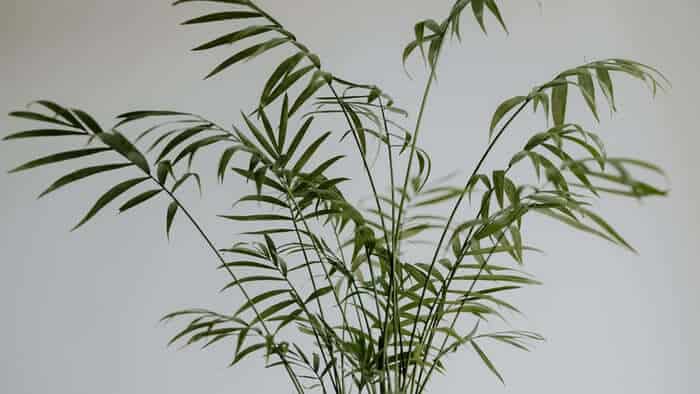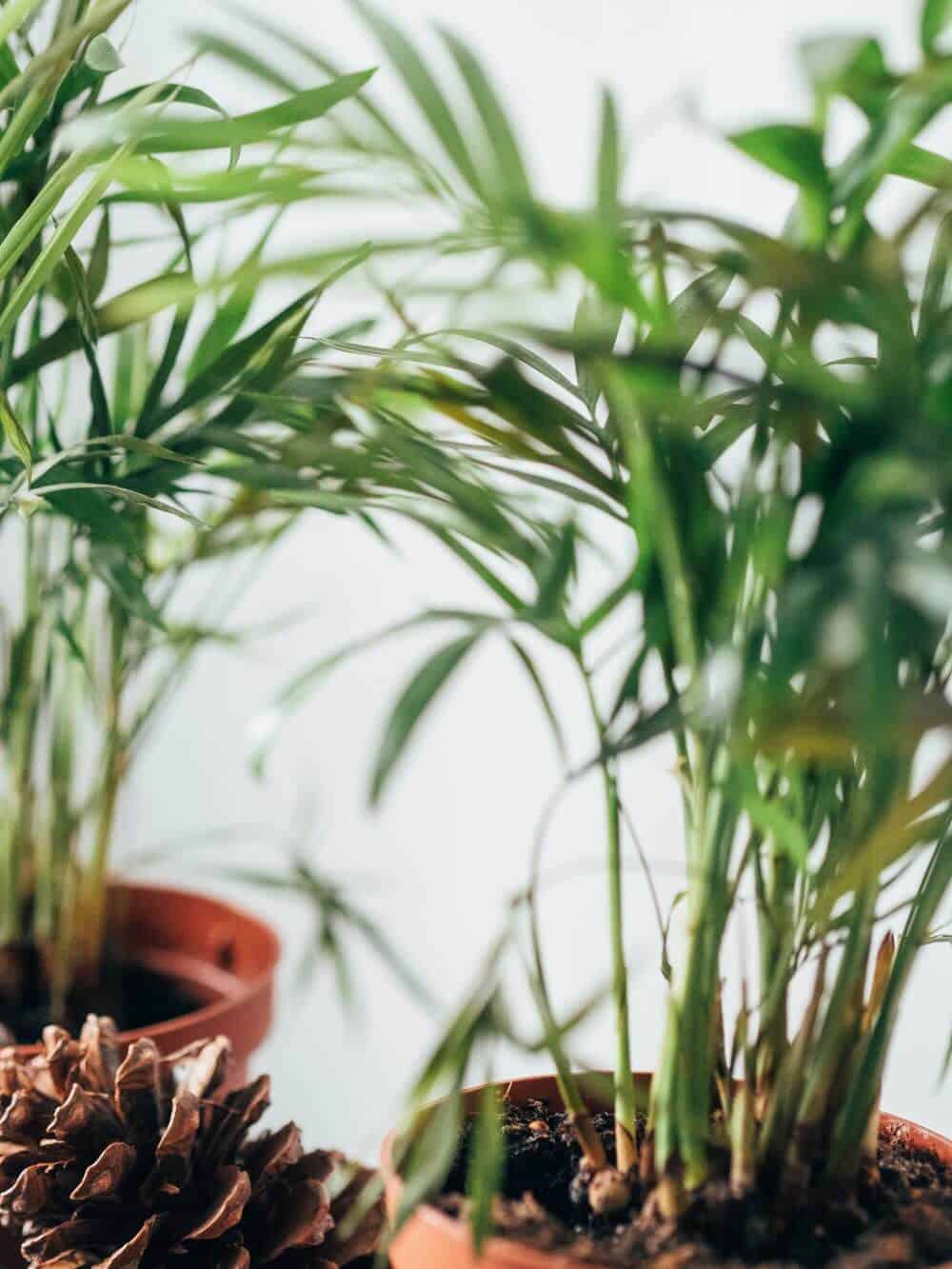Last Updated on February 6, 2023 by a Friendly Gardener
Just about everyone loves the idea of relaxing beneath a palm tree. The problem is that many climates are not the correct environment for palm tree cultivation. Nonetheless, you can cultivate an indoor palm and one of the easiest and most adaptable for indoor cultivation is the Parlor Palm.
A member of the Arecaceae family and native of beautiful Guatemala and Mexico, the Chamaedorea Elegans, is commonly referred to as the Parlor Palm. This indoor palm is popular because it will do well in low-light conditions and in somewhat lower temperatures.
It grows in clumps to form the “palm” featuring slim tree trunks with deep emerald, green foliage. Occasionally you may see a single trunk, however, the clumping form is more characteristic of Parlor Palms.
Florists regularly use the Parlor Palm’s fronds as decorative elements. The palm’s fronds are also used in wreaths, and on Palm Sunday because they survive more than a month once they are cut from the palm. And they are regularly a part of floral arrangements
Parlor palms grow slowly and can take years before they reach their height in maturity. Indoor heights generally reach 2 to 6, while outdoors they can grow to an impressive 6 to 16 feet. This Palm is considered to be exceptionally elegant with its delicate arching fronds and a delightful decorative element that asks little of its owners.
Parlor Palm Plant Care

If you have always wanted your own palm tree, this cultivar may be exactly what you are looking for especially for apartment living. The Parlor palm will also do well in businesses, offices, and lobbies with minimal proper care. It is the ideal palm for beginner gardeners. They do exceptionally well in low-light conditions meaning they can be cultivated in just about any indoor situation. One drawback can be that they have a sensitivity to overwatering, but if you travel or don’t have a lot of time, the Parlor may be perfect in this sense. Too much direct sunlight can damage fronds through burning or scorching.
Soil
A peat-based potting mix is recommended for indoor cultivation.No sponge-like soil beds. Outdoors, the parlor Palm does well in any soil type including loamy, clay, or sandy garden beds. It does not tolerate soil with high levels of salt. An acidic to neutral pH level measuring between 5.1 and 7.5. will be fine. Excellent drainage is a must and the soil bed needs to be maintained lightly moist.
Light
The Parlor Palm will manage in lower light conditions very well, nonetheless, it will not survive if it receives no light at all. Ideal lighting is bright but needs to be indirect or filtered for healthy growth.
Water
Almost all palms are sensitive to excessive watering and the parlor Palm is no exception. Never leave this plant sitting in waterlogged soil. The parlor palm will do better even if too dry than waterlogged. You can water your palm when the soil bed’s top inch feels dry to the touch. Yellow palm fronds indicate your plant needs a drink.
Humidity

The Parlor Palm does fine in a home or office environment measuring average humidity. Should leaf edges dry out and brown frond tips appear, your Parlor Palm may be asking for a drink of water. To prevent any risk of overwatering, raise the humidity level where the plant is located. The easiest method is by using a space humidifier. You can also help humidity levels by misting your palm 3 or 4 times weekly. Other alternatives include placing a receptacle of water close to the Palm.
Temperature
The proper indoor environmental temperature for the Parlor palm should measure between 65° and 80° Fahrenheit. This plant can tolerate temperatures that drop to 50°F. For outdoor Parlor palms, frost is lethal. Always protect the Parlor palm from cool drafts that arrive from air conditioning vents, windows, doors, and similar.
Feeding

During the winter season, it will not be necessary to feed your palm. The Parlor Palm feeds lightly, so you can apply fertilizer once or twice during the entire growing season. Use a diluted liquid 20-20-20 plant fertilizer.
Pruning
The ParlorPalm does not require pruning per se, as its fronds develop from a terminal bud. Only trim away old or browned fronds. If you risk pruning, fronds will cease growing.
Repotting
Parlor Palms are characterized by weak root systems. They also grow very slowly so repotting should be done with great care no more than every second year at the most. If the soil bed becomes spongy or compacted, repot to prevent root rot from setting in.
Parlor Palm Propagation

Professional nurseries usually choose to propagate this palm variety directly from seed. It is also possible to divide clumps. However, as these plants do not naturally grow in a clump formation, a division is not advised. They are seeded in clumps for purely aesthetic purposes. Both stem cuttings and frond cuttings will not afford successful propagation.
Parlor Palm Toxicity
According to the ASPCA website, Parlor Palms are not toxic to cats or to dogs, making them a safe selection as an indoor houseplant for families with small children and family pets.
Pests, Diseases, and Parlor Palm Problems

Like many popular houseplants, Parlor Palms are susceptible to common indoor pests. Be on the watch for signs of aphids, mealybugs, scale, or whitefly. Treat the palm immediately with a non-toxic organic insecticidal soap if you see evidence of infestation. You can also spray fronds with warm soapy water. Avoid completely plant solutions that contain alcohol.
The Parlor Palm is susceptible to both root rot and fungal leaf spot. These infections develop above all from overwatering, bad drainage, or excessive moisture in general.
If your Parlor Palm turns yellow or appears to be dying, it may need water.
Foliage tips that turn brown indicate overwatering, excessive fertilizer, or insufficient sunlight.
The Parlor Palm also can exhibit sensitivity to chemicals commonly found in the water. If you suspect that your municipal tap water is high in chlorine, fluoride, or other chemical compounds, collect rainwater or use distilled water for watering needs.
Parlor Palm Varieties
Several Parlor Palm varieties are popular, and you may find one of these when acquiring one.
- Chamaedorea Elegans This is the most popular Parlor Palm cultivar and the one you may most often find at garden centers and nurseries. It has its natural habitat in Mexico or in Central America.
- Chamaedorea Erumpens A bamboo palm, this variety is larger than the more popular “Elegans” cultivar. Fronds are fan-like, and it finds their natural habitat further south in the hemisphere.
- Chamaedorea Hooperiana This particular Parlor Palm variant is often confused with the Kentia Palm. Fronds are quite large and this cultivar is super easy to cultivate.
A Final Thought
This truly is the perfect indoor houseplant for those with little time for home gardening or the beginner gardener that fears being without a green thumb.
Interior designers and architects adore the ParlorPalm for its elegance and versatility. As a low-maintenance plant, it adds greenery to indoor locations without requiring much of owners, and it thrives in homes and places of business. As it grows very slowly and thrives in low-light conditions it is a lovely addition to indoor houseplant collections.

